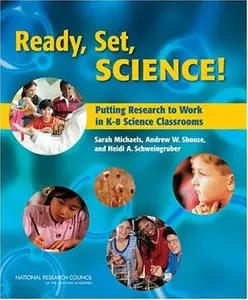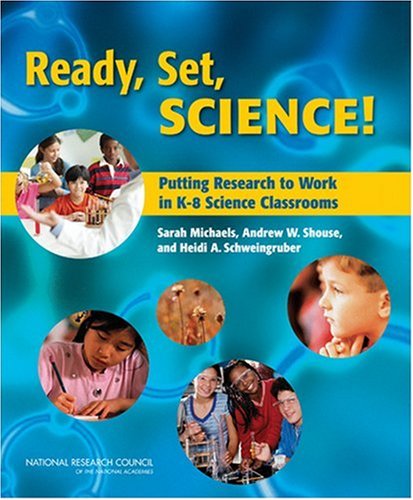"Ready, Set, SCIENCE!: Putting Research to Work in K-8 Science Classrooms" ed. by Sarah Michaels, Andrew W. Shouse, and Heidi A. Schweingruber
National Research Council
NAS Press | 2008 | ISBN: 030910615X 9780309106153 0309106141 9780309106146 | 221 pages | PDF | 40 MB
National Research Council
NAS Press | 2008 | ISBN: 030910615X 9780309106153 0309106141 9780309106146 | 221 pages | PDF | 40 MB
This book guides the way with an account of the groundbreaking and comprehensive synthesis of research into teaching and learning science in kindergarten through eighth grade. This book summarizes a rich body of findings from the learning sciences and builds detailed cases of science educators at work to make the implications of research clear, accessible, and stimulating for a broad range of science educators.
What types of instructional experiences help K-8 students learn science with understanding? What do science educators, teachers, teacher leaders, science specialists, professional development staff, curriculum designers, and school administrators need to know to create and support such experiences?
This book is filled with classroom case studies that bring to life the research findings and help readers to replicate success. Most of these stories are based on real classroom experiences that illustrate the complexities that teachers grapple with every day. They show how teachers work to select and design rigorous and engaging instructional tasks, manage classrooms, orchestrate productive discussions with culturally and linguistically diverse groups of students, and help students make their thinking visible using a variety of representational tools.
This book will be an essential resource for science education practitioners and contains information that will be extremely useful to everyone including parents directly or indirectly involved in the teaching of science.
Contents
Foreword
Preface
1 A New Vision of Science in Education
The Importance of Teaching Science Well
What Scientists Really Do
The Language of Science
Rethinking Children’s Capacity for Scientific Understanding
Science Class: Seeing Ourselves in Measurement
Science Class: Measuring and Graphing Height
Building on Knowledge, Interest, and Experience
For Further Reading
2 Four Strands of Science Learning
The Four Strands
Science Class: Biodiversity in a City Schoolyard
Examining the Four Strands in Instruction
The Interrelated Nature of the Four Strands
Science as Practice: Doing and Learning Together
For Further Reading
3 Foundational Knowledge and Conceptual Change
Identifying a Shared Base of Understanding in Young Children
Seeing Nature in New Ways Types of Conceptual Change
Using Prior Knowledge to Make Sense of the World
Science Class: Molecules in Motion
Examining Conceptual Change in Molecules in Motion
Building Understanding Over Multiple Years
For Further Reading
4 Organizing Science Education Around Core Concepts
Building on Core Concepts Over Time
Core Concepts in Relation to Standards and Benchmarks
Using Core Concepts to Build Learning Progressions
Science Class: The Mystery Box
Extending Scientific Discussion
Science Class: The Properties of Air
Teaching the Atomic-Molecular Theory at the Middle School Level
Science Class: The Nature of Gases
The Benefits of Focusing on Core Concepts and Learning Progressions
For Further Reading
5 Making Thinking Visible: Talk and Argument
Learning Through Talk and Argument
Encouraging Talk and Argument in the Classroom
Position-Driven Discussion
Science Class: Establishing Classroom Norms for Discussion
Appreciating Cultural, Linguistic, and Experiential Differences
Strategies for Inclusiveness
Science Class: Successfully Supporting Diversity
For Further Reading
6 Making Thinking Visible: Modeling and Representation
Mathematics
Data
Scale Models, Diagrams, and Maps
Modeling and Learning Progressions
Science Class: Representing Data
For Further Reading
7 Learning from Science Investigations 1
Creating Meaningful Problems
Sequencing Meaningful Instruction
Constructing and Defending Explanations
Scripting Student Roles
Science Class: Differentiating mass and Density
Science Class: Loking at Our Scientific Thinking
For Further Reading
8 A System That Supports Science Learning
Teachers as Learners
Knowledge of Science
How Students Learn Science
Knowing How to Teach Science Effectively
Providing Teachers with Opportunities to Learn
Next Steps
Notes
Appendix A Questions for Practitioners
Appendix B Assessment Items Based on a Learning Progression for Atomic-Molecular Theory
Appendix C Academically Productive Talk
Appendix D Biographical Sketches of Oversight Group and Coauthors
Index
Acknowledgments
Credits
with TOC BookMarkLinks



